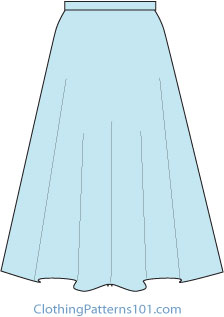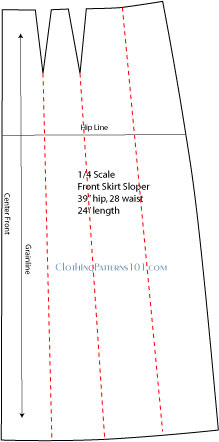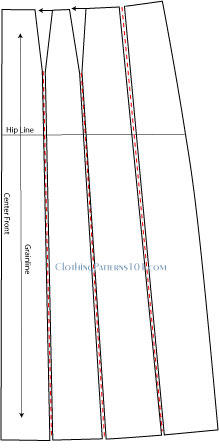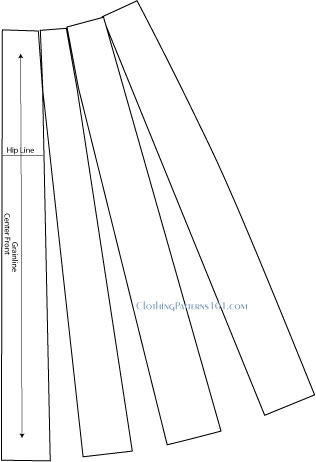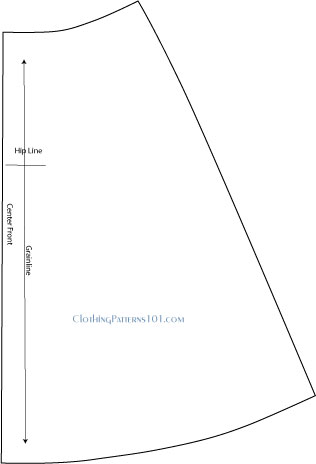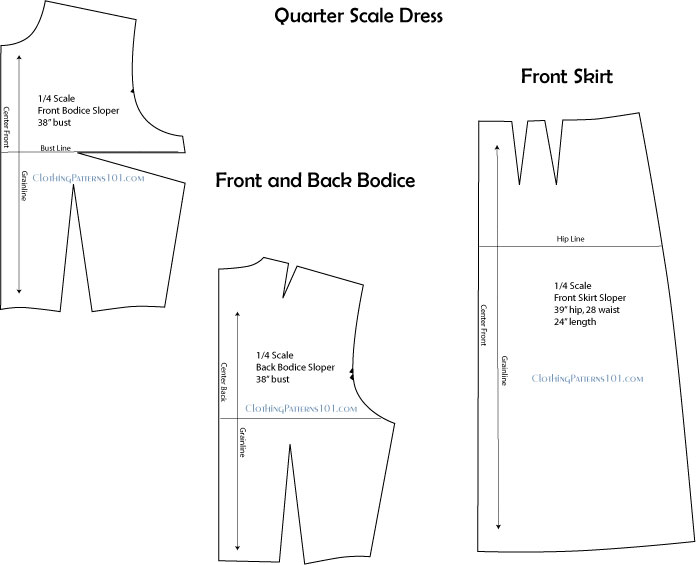- Clothing Patterns 101
- Basic Pattern Techniques
- Drafting a Full Skirt
How to Draft a Full Skirt Pattern
It's so easy to make a full skirt pattern from your basic skirt block!
It may seem like a huge variation from the fitted skirt of your basic block pattern, but it's really just a few simple steps. By "slashing and spreading" a copy of your skirt block, you can add as much - or as little - fullness as you choose.
Please note: The following directions assume you will be using your personal block to create a full-size pattern. If you are practicing pattern drafting techniques or are experimenting with pattern design, I strongly recommend you print and use our quarter scale patterns.
This variation does not include gathers at the waist.
Waist gathers add thickness to your silhouette, and generally are not flattering (unless done in a very soft fabric). You can achieve a full, swingy skirt with no excess fullness at the waist!
This is a very simple and flattering style.
Using the "Slash and Spread" Technique
Start with your skirt block (this illustration is for the front skirt pattern, but the technique will be the same for the back).
Trace a copy onto paper (this is a good time to use newsprint, if you prefer - you will NOT be using this as your final pattern!)
Draw lines from the waist to the hem as shown - starting with lines drawn from the point of the darts to the hem, and then add another line or two from the waist to the hem.
The lines should be fairly evenly spaced at both the waist and the hem, although they will be slightly farther apart at the hem.
Cut (or "slash") the pattern along the lines drawn.
THIS IS WHY YOU'LL USE NEWSPRINT OR ANOTHER, INEXPENSIVE PAPER!
This copy of your skirt block gets cut up so that you can then spread it out to add the fullness you need for your swingy skirt.
There's no need to waste your pattern paper for this part of the process -it will eventually be thrown away.
The darts will close (as shown with the arrows) when you manipulate the pieces and spread them out.
And now you just spread the pieces until you have a pleasing shape and a good amount of fullness for your skirt.
Keep the pieces touching at the top/waist.
With the darts closed, the fullness is added below the darts.
The other pieces will just touch together at the waist, and when spread they will add a bit of fullness just below the waist, at the hipline.
This is OK - the important thing is that the fullness is evenly distributed at the hem, and that the waist measurement is the same as it was originally (with the darts closed).
Connect the pieces with tape, just enough to allow you to pick it up and lay it onto the paper you'll use for your final pattern.
Finally, trace the new shape onto your brown craft paper, freezer paper, or whatever you choose for your final pattern. (Do NOT use newsprint at this point, because the print can rub off and stain your fabric). You can now throw out the newspaper pattern.
REMEMBER: Your block pattern does NOT have seam allowances or a hem. Now is the time to add seam allowances, a hem (for a full skirt, I'd use an inch or less because it's difficult to control the hem on a curve), a facing or waistband, and your markings (grainlines, fold marks if you don't want a CF seam, etc.).
Now you can use the same technique on the back and complete your skirt!
There are many more things you can do with the Slash and Spread technique. This technique allows you to add fullness anywhere on the garment that you need or want it. Use it for a variety of full sleeves or skirts, dresses or tops. The only limit is your imagination!
Before you create these dress, skirt or blouse styles, you'll need a well-fitting dress block. You can create one from a commercial pattern, or draft your dress block using your own measurements.
Once you have your fitted block, create an almost infinite variety of styles using the in-depth tutorial "A Beginner's Guide to Designing Skirts, Blouses and Dresses". Check it out now!
